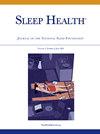小学生主观嗜睡与警觉性注意的关系
IF 3.4
2区 医学
Q2 CLINICAL NEUROLOGY
引用次数: 0
摘要
目的:儿童白天嗜睡是一个重大的公共卫生问题。本研究旨在探讨小学生主观嗜睡与警觉性注意的关系,以及年级和嗜睡对这种关系的交互作用。方法:我们从日本东京的六所小学招募了2789名学生。睡意评估采用卡罗林斯卡睡意量表(KSS)和家长报告的问卷。警觉性注意采用3分钟简短精神运动警觉性测验(PVT-B)进行测量。采用广义线性模型检验困倦与PVT-B表现指标之间的关系,包括反应速度(平均倒数反应时间,1/s)和lapse500(反应时间≥500 ms),以及困倦与等级之间的相互作用效应。结果:本横断面研究包括1955名小学生(6-12岁,男生占52%)。在反应速度(B = -0.0032,经fdr校正q < 0.05)和lapse500 (B = 0.0096,经fdr校正q < 0.01)方面,KSS与等级之间存在显著的交互作用。同样,家长报告的困倦(“在活动中入睡”)和成绩之间的显著相互作用在lapse500中被发现(B = 0.0347,经fdr调整的q < 0.05)。结论:我们的研究结果表明,儿童嗜睡和警惕注意力之间的关系因年龄而异,强调了在评估儿科人群睡眠健康时考虑发育差异的重要性。本文章由计算机程序翻译,如有差异,请以英文原文为准。
Association between subjective sleepiness and vigilant attention in elementary school students
Objectives
Daytime sleepiness in children is a significant public health concern. This study aimed to examine the association between subjective sleepiness and vigilant attention in elementary school students, as well as the interaction effects of grade and sleepiness on this association.
Methods
We enrolled 2789 students from six elementary schools in Tokyo, Japan. Sleepiness was assessed using the self-reported Karolinska Sleepiness Scale (KSS) and a parent-reported questionnaire. Vigilant attention was measured with the 3-minute brief Psychomotor Vigilance Test (PVT-B). Generalized linear models were used to examine the associations between sleepiness and PVT-B performance metrics, including response speed (mean reciprocal reaction time, 1/s) and lapse500 (number of reaction time ≥500 ms), as well as the interaction effects between sleepiness and grade.
Results
This cross-sectional study included 1955 elementary school students (aged 6-12 years; 52% boys). Significant interactions between KSS and grade were observed for response speed (B = −0.0032, FDR-adjusted q < 0.05) and lapse500 (B = 0.0096, FDR-adjusted q < 0.01). Similarly, significant interactions between parent-reported sleepiness (“falling asleep during an activity”) and grade were found for lapse500 (B = 0.0347, FDR-adjusted q < 0.05).
Conclusions
Our findings indicate that the association between sleepiness and vigilant attention among children varies by age, emphasizing the importance of considering developmental differences when evaluating sleep health in pediatric populations.
求助全文
通过发布文献求助,成功后即可免费获取论文全文。
去求助
来源期刊

Sleep Health
CLINICAL NEUROLOGY-
CiteScore
6.30
自引率
9.80%
发文量
114
审稿时长
54 days
期刊介绍:
Sleep Health Journal of the National Sleep Foundation is a multidisciplinary journal that explores sleep''s role in population health and elucidates the social science perspective on sleep and health. Aligned with the National Sleep Foundation''s global authoritative, evidence-based voice for sleep health, the journal serves as the foremost publication for manuscripts that advance the sleep health of all members of society.The scope of the journal extends across diverse sleep-related fields, including anthropology, education, health services research, human development, international health, law, mental health, nursing, nutrition, psychology, public health, public policy, fatigue management, transportation, social work, and sociology. The journal welcomes original research articles, review articles, brief reports, special articles, letters to the editor, editorials, and commentaries.
 求助内容:
求助内容: 应助结果提醒方式:
应助结果提醒方式:


